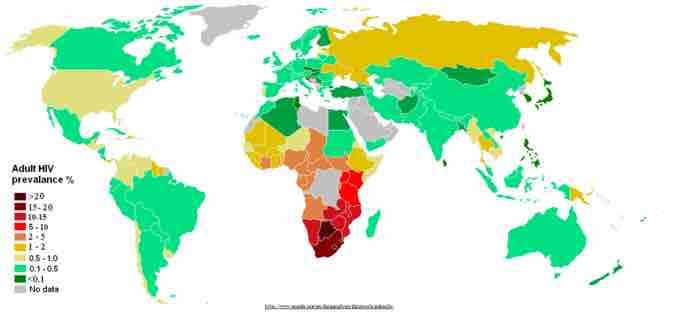Human immunodeficiency virus infection / acquired immunodeficiency syndrome (HIV/AIDS) is a disease of the human immune system caused by the human immunodeficiency virus (HIV). The illness interferes with the immune system, making people with AIDS much more likely to get infections, including opportunistic infections and tumors that do not usually affect people with working immune systems. This susceptibility increases as these disease gets worse.
HIV is transmitted primarily via sexual intercourse (including oral sex and anal sex), contaminated blood transfusions and hypodermic needles, and from mother to child during pregnancy, delivery, or breastfeeding. Prevention of HIV infection, primarily through safe sex and needle-exchange programs, is a key strategy to control the disease. There is no known cure for or vaccine against HIV, but antiretroviral treatment can slow the course of the disease and may lead to a near-normal life expectancy for people with HIV. Antiretroviral treatment reduces the risk of death and complications from the disease. However, these medications are expensive and may be associated with side effects of their own.
HIV/AIDS and World Health
HIV/AIDS is a major health problem in many parts of the world, and is considered a pandemic—a disease outbreak which is present over a large area and is actively spreading. In 2009, the World Health Organization (WHO) estimated that there are 33.4 million people worldwide living with HIV/AIDS, with 2.7 million new HIV infections per year and 2.0 million annual deaths due to AIDS. Of the approximately 34 million people infected with HIV/AIDS, approximately 16.8 million are women and 3.4 million are younger than 15 years old. AIDS was first recognized by the Centers for Disease Control and Prevention (CDC) in 1981 and its cause, HIV, was identified in the early 1980s.

Map of AIDS Prevalence Among Young Adults
AIDS prevalence is distributed unequally across the world, with sub-Saharan Africa and Southeast Asia experiencing the worst of the pandemic.
Sub-Saharan Africa is the region most affected by the global HIV/AIDS pandemic. In 2010, an estimated 68% (22.9 million) of all HIV cases and 66% of all deaths (1.2 million) occurred in this region. About 5% of the sub-Saharan African adult population is infected and HIV/AIDS is believed to be the cause of 10% of all deaths in children. Women compose nearly 60% of cases in the region. South Africa has the largest population of people with HIV of any country in the world, at 5.9 million.
South and Southeast Asia is the second most affected region in the world. In 2010, this region had an estimated 4 million cases, or 12% of all people living with HIV, resulting in approximately 250,000 deaths. Approximately 2.4 million of these cases are in India.
Prevalence is lowest in Western and Central Europe at 0.2% and East Asia at 0.1%. In 2008 in the United States, approximately 1.2 million people were living with HIV, resulting in about 17,500 deaths. The CDC estimated that in 2008 20% of infected Americans were unaware of their infection.
Prevention
Many international organizations are working to reduce the spread of HIV/AIDS and its mortality rate. Campaigns have attempted to distribute condoms to HIV/AIDS stricken regions–consistent condom use reduces the risk of HIV transmission by approximately 80% over the long-term. Circumcision in sub-Saharan Africa has been found to reduce the risk of HIV infection in heterosexual men by between 38% and 66% over two years. Based on these studies, the World Health Organization has recommended male circumcision as a method of preventing female-to-male HIV transmission. Additionally, early treatment of HIV-infected people with antiretrovirals protected 96% of sexual partners from infection.
Treatment
People infected with HIV/AIDS can be treated with anti-retroviral drugs. This medication can relieve many of the symptoms associated with the infection, such as increased susceptibility to other viral infections. Moreover, benefits of treatment include a decreased risk of progression from HIV to AIDS and a decreased risk of death. Medication can also include a decreased risk of transmission of the disease to sexual partners and a decrease in mother to child transmission. However, these drugs often have significant side effects and they are expensive, making them difficult to access in low-income countries.